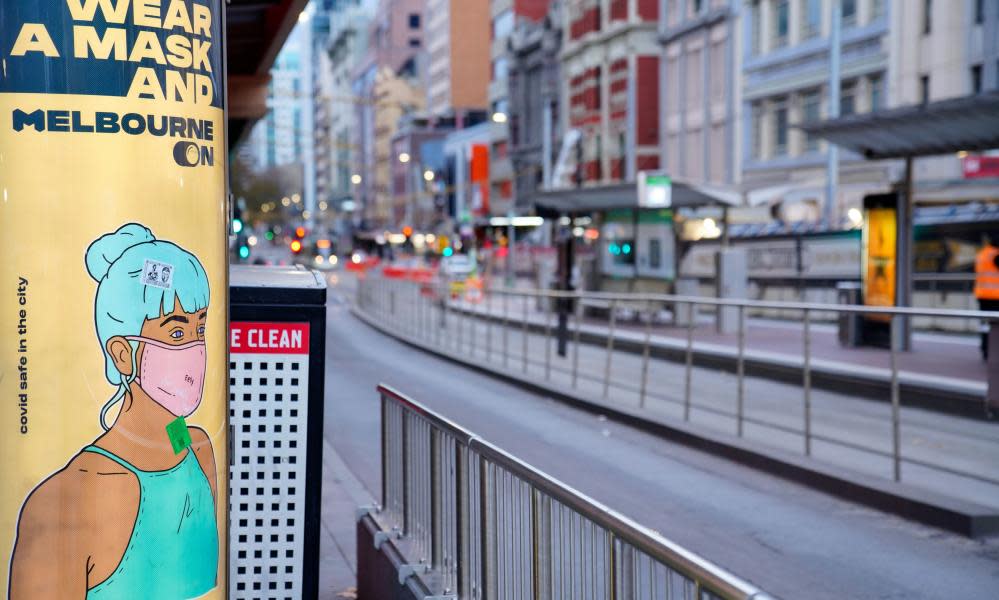Bad luck or bad management: why has Victoria had so many Covid outbreaks?

Victoria has started its seven-day circuit-breaker lockdown – its fourth lockdown since the coronavirus pandemic began.
Other states have also imposed snap lockdowns or restrictions as a result of Covid cases in the community, most recently New South Wales, after a mystery case. But, with the exception of Sydney’s northern beaches cluster, most leaks from hotel quarantine have not resulted in sizeable outbreaks.
So has Victoria just been unlucky, or are there other factors that affect how Covid-19 is transmitted in the state?
default
Is community spread down to bad luck?
James McCaw, a professor of mathematical biology at the University of Melbourne, says chance is a dominant factor, because there is a huge amount of variability in how many people an individual infected with Covid-19 spreads the virus to.
In the early stages of an outbreak, the virus has a distinct pattern of spread known as clustered transmission, which is highly unpredictable.
An estimated 70% of infected individuals do not pass the virus on to anybody else, and research has shown that around 20% of people – so-called “super-spreaders” – are responsible for the vast majority of viral transmission.
The pattern of spread was similar for Sars, and differs from other viruses such as those that cause the flu, which are transmitted more consistently.
“In terms of control, that works in our favour,” McCaw says. When a leak in hotel quarantine infection controls occurs, by far the most likely outcome is that Covid-19 spreads to nobody or to only one person, he says. “Often, someone gets it, they get through the [infection control] system, but they don’t pass it on to anyone and we avoid an outbreak.
“We saw that in Western Australia and we’ve seen it many other times where an infected person is in the community.”
Hassan Vally, an associate professor in epidemiology at Latrobe University, agrees Victoria’s latest lockdown is the unlucky result of someone shedding high amounts of virus after quarantining in South Australia.
“Any other state could face this similar situation,” Vally says. “We’ve got to be careful that we don’t blame Victoria for this.”
Does Covid spread faster in cold weather?
Covid-19 transmission seems to be faster in winter, says James Trauer, an associate professor at Monash University.
Related: Record pace of Melbourne Covid outbreak and delayed vaccine rollout blamed for Victoria lockdown
Research suggests the virus doesn’t last as long on hotter surfaces, and surges in coronavirus cases in the northern hemisphere have coincided with winter months.
“It could be biological or it could be behavioural,” Trauer says. “It could just be that people are spending more time inside and we know more and more that aerosol transmission is important.
“As happened in hotel quarantine in South Australia, it can transmit to people, through this airborne route, who are more than 1.5 metres away from each other.”
It is plausible that the cold climate in Melbourne, as Australia’s most populous southern city, makes it more prone to Covid-19 outbreaks than cities in other states, but it’s too early to know for certain, McCaw says. “We haven’t seen enough winters [with Covid-19] yet.”
Are there other factors that make Victoria susceptible?
Dr Beverley Paterson at the University of Newcastle suggests that a higher degree of connectedness between Melbourne residents than those in other cities could be a contributing factor – though this would be difficult to quantify.
Related: Covid Victoria lockdown restrictions: new Melbourne and regional Vic coronavirus rules explained
“When you look at the outbreaks, there are a lot of exposures within family groups and workplaces,” she says.
Based on social distancing behaviours at present, the statistical potential for Covid-19 transmission is actually the lowest in Victoria compared to all other states and territories.
Though Victoria’s Covid-19 cases have been concentrated in Melbourne, the city’s high population density does not seem to have had any effect on outbreak risk, McCaw says.
When the virus infects parts of the population for whom social distancing is more difficult – such as in lower socioeconomic areas where household size is smaller – the spread has been more rapid.
“All cities in Australia have a spectrum of socioeconomic areas,” McCaw says. “There’s nothing in particular about Melbourne.”
Are errors in contact tracing a factor?
Contract tracing errors – such as the misidentification of a Woolworths location in northern Melbourne – have been criticised in recent days.
Victoria’s chief health officer, Prof Brett Sutton, has defended the state’s contact tracing program, which quickly identified more than 10,000 primary and secondary contacts and 150 potential exposure sites. “Now is not the time to try to find an imaginary scapegoat,” he tweeted on Thursday.
“We are much better placed to deal with this in Victoria than we were 12 months ago,” Vally says.
Crucially, the virus’s behaviour has changed in the past year, says Prof Bruce Thompson at Swinburne University of Technology. There are now more than 100 variants of the Sars-CoV-2 virus in circulation.
The Covid-19 strain responsible for the latest Victorian cluster – B.1.617.1, first identified in India – appears to have a far faster transmission rate than other variants.
Victoria’s acting premier, James Merlino, noted on Thursday that the serial interval – the time between successive Covid-19 cases – has dropped from a usual five to six days down to as little as one day.
Such rapid transmission has not been recorded elsewhere in the world, Paterson says.
“That changes everything,” she says. “In Australia, where we have so few cases, it’s like a real-world experiment … you can track an exposure.”
The Victorian lockdown is a reminder that among a largely unvaccinated population, a sense of complacency may be premature, Vally says.
“The most effective way of dealing with this [in future] is to get vaccinated,” Thompson says.

 Yahoo News
Yahoo News 
